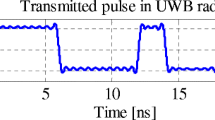Abstract
A cepstrum moving target detection (CEPMTD) algorithm based on cepstrum techniques is proposed for passive coherent location (PCL) radar systems. The primary cepstrum techniques are of great success in recognizing the arrival times of static target echoes. To estimate the Doppler frequencies of moving targets, we divide the radar data into a large number of segments, and reformat these segments into a detection matrix. Applying the cepstrum and the Fourier transform to the fast and slow time dimensions respectively, we can obtain the range information and Doppler information of the moving targets. Based on the CEPMTD outlined above, an improved CEPMTD algorithm is proposed to improve the detection performance. Theoretical analyses show that only the target’s peak can be coherently added. The performance of the improved CEPMTD is initially validated by simulations, and then by experiments. The simulation results show that the detection performance of the improved CEPMTD algorithm is 13.3 dB better than that of the CEPMTD algorithm and 6.4 dB better than that of the classical detection algorithm based on the radar cross ambiguity function (CAF). The experiment results show that the detection performance of the improved CEPMTD algorithm is 1.63 dB better than that of the radar CAF.
Similar content being viewed by others
References
Andric, M.S., Bujakovic, D.M., Bondzulic, B.P., et al., 2011. Cepstrum-based analysis of radar Doppler signals. Proc. 10th Int. Conf. on Telecommunication in Modern Satellite Cable and Broadcasting Services, p.575–578. [doi:10.1109/TELSKS.2011.6143180]
Axelsson, S.R.J., 2004. Noise radar using random phase and frequency modulation. IEEE Trans. Geosci. Remote Sens., 42(11):2370–2384. [doi:10.1109/TGRS.2004.834589]
Bogert, B.P., Healy, M.J.R., Tukey, J.W., 1963. The quefrency analysis of time series for echoes: cepstrum, pseudoautocovariance, cross-cepstrum and saphe cracking. Proc. Symp. on Time Series Analysis, p.209–243.
Cherniakov, M., 2008. Bistatic Radars: Emerging Technology. John Wiley & Sons, Inc., UK.
Hansson-Sandsten, M., Axmon, J., 2007. Multiple-window cepstrum analysis for estimation of periodicity. IEEE Trans. Signal Process., 55(2):474–481. [doi:10.1109/TSP.2006.885759]
Kemerait, R., Childers, D.G., 1972. Signal detection and extraction by cepstrum techniques. IEEE Trans. Inform. Theory, 18(6):745–759. [doi:10.1109/TIT.1972.1054926]
Kim, H.K., Rose, R.C., 2003. Cepstrum-domain acoustic feature compensation based on decomposition of speech and noise for ASR in noisy environments. IEEE Trans. Speech Audio Process., 11(5):435–446. [doi:10.1109/ TSA.2003.815515]
Kim, H.K., Rose, R.C., 2009. Cepstrum-domain model combination based on decomposition of speech and noise using MMSE-LSA for ASR in noisy environments. IEEE Trans. Audio Speech Lang. Process., 17(4):704–713. [doi:10.1109/TASL.2008.2012319]
Li, J., Lu, X., Zhao, Y., 2012. A novel algorithm for side peaks suppression of ambiguity function for passive radar based on Chinese DTTB signal. J. Electron. (China), 29(6): 485–492. [doi:10.1007/s11767-012-0912-x]
Li, J., Zhao, Y., Lu, X., dy2013. The impact of step selection in NLMS algorithm on low velocity target detecting for passive radar. Proc. IET Int. Radar Conf. [doi:10.1049/cp.2013.0359]
Malanowski, M., Kulpa, K., Kulpa, J., et al., 2014. Analysis of detection range of FM-based passive radar. IET Radar Sonar Navig., 8(2):153–159. [doi:10.1049/iet-rsn.2013.0185]
Noll, A.M., 1964. Short-time spectrum and “Cepstrum” techniques for vocal-pitch detection. J. Acoust. Soc. Am., 36(2):296–302. [doi:10.1121/1.1918949]
Noll, A.M., 1967. Cepstrum pitch determination. J. Acoust. Soc. Am., 41(2):293–309. [doi:10.1121/1.1910339]
Olivadese, D., Giusti, E., Petri, D., et al., 2013. Passive ISAR with DVB-T signals. IEEE Trans. Geosci. Remote Sens., 51(8):4508–4517. [doi:10.1109/TGRS.2012.2236339]
Oppenheim, A.V., 1965. Superposition in a Class of Nonlinear Systems. PhD Thesis, MIT Research Laboratory of Electronics, Cambridge, USA.
Oppenheim, A.V., Schafer, R.W., 2004. From frequency to quefrency: a history of the cepstrum. IEEE Signal Process. Mag., 21(5):95–106. [doi:10.1109/MSP.2004.1328092]
Palmer, J.E., Harms, H.A., Searle, S.J., et al., 2013. DVB-T passive radar signal processing. IEEE Trans. Signal Process., 61(8):2116–2126. [doi:10.1109/TSP.2012.2236324]
Schafer, R.W., 1969. Echo Removal by Discrete Generalized Linear Filtering. Technical Report, MIT Research Laboratory of Electronics, Cambridge, USA.
Sinsky, A.I., Wang, C., 1974. Standardization of the definition of the radar ambiguity function. IEEE Trans. Aerosp. Electron. Syst., AES-10(4):532–533. [doi:10.1109/TAES. 1974.307831]
Stoffa, P.L., Buhl, P., Bryan, G.M., 1974. The application of homomorphic deconvolution to shallow-water marine seismology—Part I: models. Geophysics, 39(4):401–416. [doi:10.1190/1.1440438]
Thomas, J.M., Griffiths, H.D., Baker, C.J., 2006. Ambiguity function analysis of digital radio mondiale signals for HF passive bistatic radar. Electron. Lett., 42(25):1482–1483. [doi:10.1049/el:20062896]
Tsai, W.H., Lin, H.P., 2011. Background music removal based on cepstrum transformation for popular singer identification. IEEE Trans. Audio Speech Lang. Process., 19(5): 1196–1205. [doi:10.1109/TASL.2010.2087752]
Ulrych, T.J., 1971. Application of homomorphic deconvolution to seismology. Geophysics, 36(4):650–660. [doi:10. 1190/1.1440202]
Yan, H., Shen, G., Zetik, R., et al., 2013. Ultra-wideband MIMO ambiguity function and its factorability. IEEE Trans. Geosci. Remote Sens., 51(1):504–519. [doi:10. 1109/TGRS.2012.2201486]
Author information
Authors and Affiliations
Corresponding author
Additional information
ORCID: Ji-chuan LI, http://orcid.org/0000-0003-0314-4475
Rights and permissions
About this article
Cite this article
Li, Jc., Lu, Xd., Zhang, H. et al. Moving target detection in the cepstrum domain for passive coherent location (PCL) radar. Frontiers Inf Technol Electronic Eng 16, 785–795 (2015). https://doi.org/10.1631/FITEE.1500036
Received:
Accepted:
Published:
Issue Date:
DOI: https://doi.org/10.1631/FITEE.1500036
Keywords
- Moving target detection
- Cepstrum techniques
- Cross ambiguity function (CAF)
- Passive coherent location (PCL) radar




